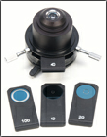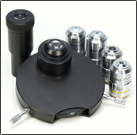



Illumination explained

Most of the detail of living cells (such as pond life or cell culture) is undetectable in standard bright field microscopy because there is too little contrast between structures with similar transparency and there is insufficient natural pigmentation for colour to be a distinguishing feature. However the various internal elements of cells do have a relatively wide variation in refractive index, that is, the tendency of the materials to bend and slow light. This provides an opportunity to distinguish between them.
Highly refractive structures bend light to a much greater angle than do structures of low refractive index. The same properties that cause the light to bend also delay the passage of light by a ¼ of a wavelength or so. In a light microscope in bright field mode, light from highly refractive structures bends farther away from the centre of the lens than light from less refractive structures and arrives about a ¼ of a wavelength out of phase. Light from most objects passes through the centre of the lens as well as the periphery. If the light from an object to the edges of the objective lens is retarded by half a wavelength and the light to the centre is not retarded at all, then the light rays are out of phase by half a wavelength. They cancel each other out when the objective lens brings the image into focus. A reduction in the brightness of the object is seen, and the degree of reduction depends on the refractive index of the object,
Phase contrast is preferable to bright field microscopy when high magnifications are needed (x400 and x1000). Most living microscopic organisms are much more obvious in phase contrast.
To achieve phase contrast, specialised phase objectives and phase condensers are needed which add considerably to the cost of a microscope. The objectives have a ring of retardant material that delays light passing through it by ¼ of a wavelength, when the minor differences caused by cellular components are added to this , there is enough wavelength interference to give a visual effect.
There are a number of options:
1) Zernicke phase system. This consists of a full set of phase objectives with an off centre phase condenser with a rotating table that includes phase rings suitable for each of the objectives.
2) Slider phase system. In order to reduce costs the slider system allows the option of two phase objectives (x10 and x20) or (x40 and x100) with a condenser that allows the equivalent phase ring to be pushed/pulled into the optical path.
3) Insert phase system. For those who only require single magnification phase contrast, the insert system allows the purchase of a single phase objective together with a condenser with a slot to allow the insertion of a phase ring to match the objective. Additional objectives and insert rings can of course be purchased.
Phase contrast techniques can be particularly rewarding, and the full Zernicke system is ideal for commercial/professional applications. The slider and insert systems permit the use of this technology for those on a more restricted budget. The individual descriptions of the microscopes within this web site will indicate which units are suitable. The animation on the left may take a few minutes to download, but will explain how each of the systems work.

















Brunel Microscopes Ltd
Registered in U.K. (England) No: 2060047
find us on youtube, facebook and twitter


















| Pocket microscopes /hand lenses |
| Budget Stereos |
| Lab Stereos |
| Zoom Stereos |
| Long arm Stereos |
| Gemscopes |
| Inspection & QC Stereos |
| Zoom Monoscopes |
| High Power Digital |
| Handheld & Desk Top |
| Digital Stereos |
| Digital Cameras |